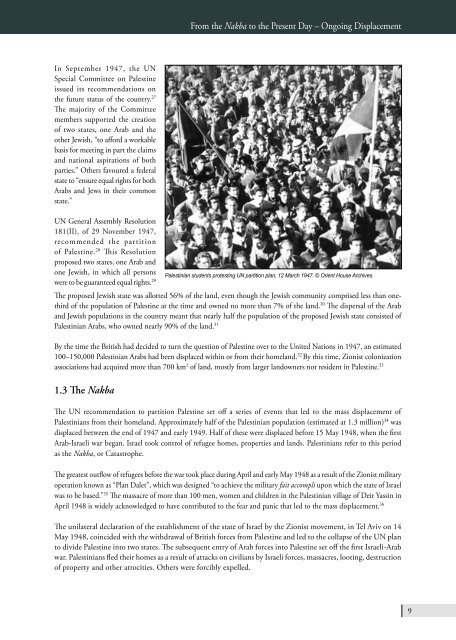BADIL Resource Center for Palestinian Residency and Refugee
BADIL Resource Center for Palestinian Residency and Refugee
BADIL Resource Center for Palestinian Residency and Refugee
You also want an ePaper? Increase the reach of your titles
YUMPU automatically turns print PDFs into web optimized ePapers that Google loves.
In September 1947, the UN<br />
Special Committee on Palestine<br />
issued its recommendations on<br />
the future status of the country. 27<br />
The majority of the Committee<br />
members supported the creation<br />
of two states, one Arab <strong>and</strong> the<br />
other Jewish, “to af<strong>for</strong>d a workable<br />
basis <strong>for</strong> meeting in part the claims<br />
<strong>and</strong> national aspirations of both<br />
parties.” Others favoured a federal<br />
state to “ensure equal rights <strong>for</strong> both<br />
Arabs <strong>and</strong> Jews in their common<br />
state.”<br />
UN General Assembly Resolution<br />
181(II), of 29 November 1947,<br />
recommended the partition<br />
of Palestine. 28 This Resolution<br />
proposed two states, one Arab <strong>and</strong><br />
one Jewish, in which all persons<br />
were to be guaranteed equal rights. 29<br />
From the Nakba to the Present Day – Ongoing Displacement<br />
The proposed Jewish state was allotted 56% of the l<strong>and</strong>, even though the Jewish community comprised less than onethird<br />
of the population of Palestine at the time <strong>and</strong> owned no more than 7% of the l<strong>and</strong>. 30 The dispersal of the Arab<br />
<strong>and</strong> Jewish populations in the country meant that nearly half the population of the proposed Jewish state consisted of<br />
<strong>Palestinian</strong> Arabs, who owned nearly 90% of the l<strong>and</strong>. 31<br />
By the time the British had decided to turn the question of Palestine over to the United Nations in 1947, an estimated<br />
100–150,000 <strong>Palestinian</strong> Arabs had been displaced within or from their homel<strong>and</strong>. 32 By this time, Zionist colonization<br />
associations had acquired more than 700 km 2 of l<strong>and</strong>, mostly from larger l<strong>and</strong>owners not resident in Palestine. 33<br />
1.3 The Nakba<br />
<strong>Palestinian</strong> students protesting UN partition plan, 12 March 1947. © Orient House Archives.<br />
The UN recommendation to partition Palestine set off a series of events that led to the mass displacement of<br />
<strong>Palestinian</strong>s from their homel<strong>and</strong>. Approximately half of the <strong>Palestinian</strong> population (estimated at 1.3 million) 34 was<br />
displaced between the end of 1947 <strong>and</strong> early 1949. Half of these were displaced be<strong>for</strong>e 15 May 1948, when the first<br />
Arab-Israeli war began. Israel took control of refugee homes, properties <strong>and</strong> l<strong>and</strong>s. <strong>Palestinian</strong>s refer to this period<br />
as the Nakba, or Catastrophe.<br />
The greatest outflow of refugees be<strong>for</strong>e the war took place during April <strong>and</strong> early May 1948 as a result of the Zionist military<br />
operation known as “Plan Dalet”, which was designed “to achieve the military fait accompli upon which the state of Israel<br />
was to be based.” 35 The massacre of more than 100 men, women <strong>and</strong> children in the <strong>Palestinian</strong> village of Deir Yassin in<br />
April 1948 is widely acknowledged to have contributed to the fear <strong>and</strong> panic that led to the mass displacement. 36<br />
The unilateral declaration of the establishment of the state of Israel by the Zionist movement, in Tel Aviv on 14<br />
May 1948, coincided with the withdrawal of British <strong>for</strong>ces from Palestine <strong>and</strong> led to the collapse of the UN plan<br />
to divide Palestine into two states. The subsequent entry of Arab <strong>for</strong>ces into Palestine set off the first Israeli-Arab<br />
war. <strong>Palestinian</strong>s fled their homes as a result of attacks on civilians by Israeli <strong>for</strong>ces, massacres, looting, destruction<br />
of property <strong>and</strong> other atrocities. Others were <strong>for</strong>cibly expelled.<br />
9

















